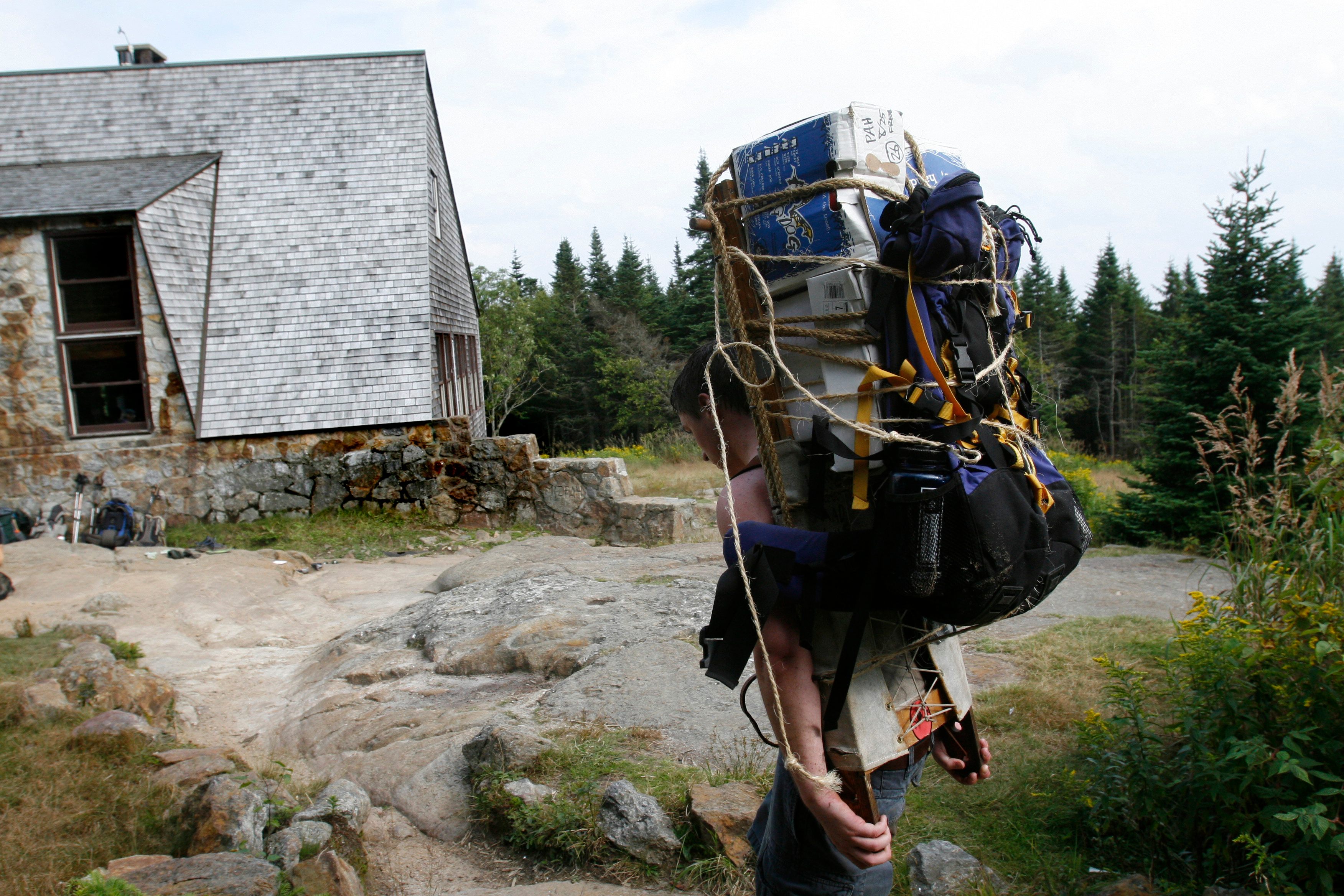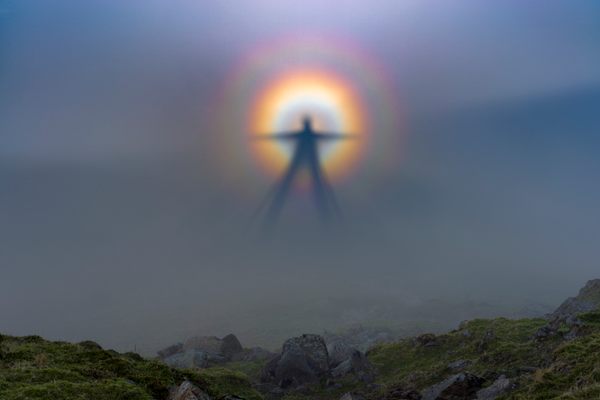The ‘Croos’ That Haul 50-Pound Packs to Feed Hungry Hikers
Re-supplying White Mountains huts requires serious stamina.

My husband and I had just departed the windy Mount Washington summit, the highest point in the Northeast and the fourth of seven peaks in the Presidential Traverse hike through New Hampshire’s White Mountains. Suddenly, a shirtless, shaggy-haired twentysomething sidestepped us. Not only was he shouldering a crammed packboard—an almost-primitive contraption made of wood, canvas, and leather stacked with food and supplies—but he was practically running, sure-footed on the rocky trail down to the Lakes of the Clouds Hut. Minutes later, a young woman carrying an equally hulking load hurried by in the opposite direction.
Meet the croo, a merry band of mostly college-age staffers who feed and entertain overnight guests at the Appalachian Mountain Club’s (AMC’s) eight backcountry huts from late May through mid-fall. All told, the croo prepares almost 2,300 family-style breakfasts and dinners each year. On Wednesdays and Saturdays, they lug trash and recycling out of the shelters, each one returning the same day with 40 to 80 pounds of vegetables, frozen meat, butter, and lots of cheese—ingredients destined for memorable meals that bushed hikers savor in a breathtaking setting.
“I don’t think I’ve ever had a job where you could make a little bit of money and have that much fun—it was wild, really,” says Ethan Hipple, deputy director of the Parks, Recreation and Facilities Department of Portland, Maine. “There’s a totally unique culture among the 50 or so people who work in the huts each summer.” Hipple was on the croo in the mid-nineties, where he also met his wife, Sarah.

The White Mountains, a segment of the Appalachian Mountains that extends for 85 miles across New Hampshire and into Maine, have beckoned adventurers for centuries. Founded in 1876, the AMC opened its first shelter for hikers and researchers 13 years later: the Madison Spring Hut, perched at 4,800 feet in the col between Mount Adams and Mount Madison.
In 1906, the AMC hired a “care-keeper” for the hut, a role that evolved into hutmaster and, eventually, multi-person crews (or croos, in AMC parlance). During the first half of the 20th century, the club built five additional lodges—Carter Notch, Lakes of the Clouds, Greenleaf, Zealand Falls, and Galehead—and acquired Lonesome Lake Hut.
“It is always a joy to me to watch the hungry eyes of a camp group … following the motions of a hutman carving a turkey,” wrote Supreme Court Associate Justice William O. Douglas in his article, “The Friendly Huts of the White Mountains,” for the August 1961 issue of National Geographic. “The aroma of a crisp brown bird, bubbling soup, and hot biscuits seems magically to take the ache out of tired feet.”
Douglas’ splashy feature was a boon for the region and led to the construction of the eighth and final hut three years later: Mizpah Spring Hut. By then, women had joined the croos, and in 1979, Lonesome Lake Hut saw its first all-female squad.
Today, the huts host 36 to 90 guests at capacity and are run by five to 11 croo members. (Lakes of the Clouds, dubbed “Lakes of the Crowds,” sleeps the most people.) Home-cooked meals are the main attraction, of course, and hut binders display well-loved recipes—think lentil soup, dijon mustard chicken, lasagna, garlic-cheddar bread, and vegan chocolate cake. To ensure hut-hopping backpackers enjoy variety evening after evening, each hut makes a variation on the same entree on the same night of the week—stuffed shells on Sunday, beef on Monday, and so on.

Before the season starts, croos attend a five-day training, including six or so hours on cooking and baking. “Still, a lot of learning happens on the job,” says AMC Huts Manager James Wrigley, who gleaned tips, such as browning meat to boost flavor, from veteran staffers during his hut stints in the mid-2000s. All this advice and oral tradition comes in handy as croo members take turns manning the kitchen.
Days start early, at 5 a.m., when the cook on duty fires up the griddle. “It’s dark and you’re in your headlamp, and it’s just you smelling the coffee,” recalls Hipple. “The sun is rising, and the valley is filled with fog, and you see the mountains sticking up above the clouds—you’re just in this other world above everything.”
Remaining staffers rise, ready the tables, and rouse the guests. A breakfast (perhaps pancakes, also known as “cakers,” plus sausage or bacon, fruit, eggs, and hot cereal) is ready at 7 a.m. After clean-up and the croo-led BFD—a blanket-folding demo instructing guests how to, ahem, fold their linens, as well as reminding them to leave no trace, stay on the trail, and tip the staff—the cook preps dinner throughout the day, all the while acting as a concierge for arriving lodgers. At 5 p.m., it’s go-time: The croo reconvenes, and the cook delegates salad-making and table-setting duties, while putting finishing touches on the four-course meal, served at 6 p.m. Coffee caps off the evening.
Hut visitors are a “self-selecting group,” says Wrigley. “They got to the backcountry, and then to have someone serve them food, it’s like, ‘Wow, this is wonderful.’” So while Hipple remembers that his grandmother’s beet borscht received mixed reviews, most dishes are hits.
Once the lights are out, the croo heads for bed, or to the trails for a nocturnal raid. Leaving a couple croo members with sleeping guests, the others hike along the ridge to deliver treats and pilfer garden gnomes, rocking chairs, and other prizes from nearby huts. Hijinks are part of the culture, which calls for wearing costumes to presentations, using hut-specific slang, and sending lodgers off to bed with impromptu concerts.

These after-dark blitzes have been going on for decades, par for the course in a summer job so steeped in tradition that it’s even impervious to social media. “It’s a lot of fun—and these days, unfortunately, rare—to spend a night playing games, watching the sunset, or looking through a telescope instead of using screens,” says Whitney Brown, AMC Huts Field Supervisor and a 2013-2015 croo alum. “It is rewarding that the huts facilitate … these types of experiences.”
Another time-honored practice: While helicopters supplanted donkeys and manpower for hauling dry goods to high summits in the 1960s—in May, they airlift an average of 16,000 pounds of supplies including propane, flour, and tomato puree to each AMC Hut—croo members still schlepp broken-in packboards of fresh, increasingly local produce twice a week.
The supply sojourns vary from one-and-a-half to over five miles one way, depending on the hut. “I was in the best shape of my life,” Hipple says about the summer he worked at Madison Spring Hut. On his first day, however, he hauled his clothing, a guitar, and a 60-pound packboard up the steep-in-parts 3.8 miles, and “by the time I got to the top, I was grasping at saplings.” But over the season, it becomes a manageable, even enjoyable, task. “When you’re doing it twice a week, you get pretty strong,” Brown says. “It’s an empowering feeling.”
But all the work is worth it to witness hut guests break bread at communal tables.
“It’s building a community in a way that we don’t see a lot of anymore,” Wrigley says. “There are all these folks from across the country and the globe, from different walks of life, who are talking about their hikes and sharing food.”
Gastro Obscura covers the world’s most wondrous food and drink.
Sign up for our regular newsletter.






























Follow us on Twitter to get the latest on the world's hidden wonders.
Like us on Facebook to get the latest on the world's hidden wonders.
Follow us on Twitter Like us on Facebook